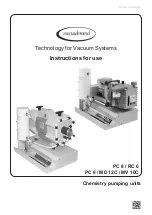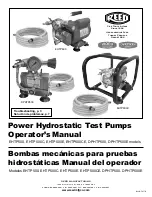
WATER SOURCE LLC
4
WWW.WATERSOURCEUSA.COM
GENERAL INFORMATION:
1. Water Source pumps are equipped with either a wide-angle float switch or vertical float switch. The
pump will automatically turn on when the water level in the sump pit reaches the float switch "on"
level and automatically turn off when the water is pumped down to the float switch "off" level.
Approximate height of float switch above base of pump
Float Switch Type
On Level
Off Level
Wide-angle (tethered)
13 in.
5 in.
Vertical
5 in.
1 ¼ in.
2. Make sure the wide-angle float switch will swing freely from the bottom to top without coming in
contact with the side of the sump pit. Contact with the side of the sump pit may cause the switch to
malfunction. Make sure the vertical float switch does not become bent and can rise and fall without
coming into contact with side of pump or side of sump pit.
If the float switch cannot come down
properly, the pump will not turn off, which will burn out the pump motor and flood your basement!
3. The sump pit must be a minimum of 12" diameter by 10" depth for
vertical float switch
models; 18"
diameter by 18" depth for
wide-angle float switch
models to prevent excessive pump cycling.
4. Based on the float switch operation, this pump will not remove all the water in the sump pit.
5. Set your new pump in the bottom of the sump pit off to one side. The pump MUST be placed on a solid
foundation, such as a brick, stone paver, or other flat heavy surface. Do not place the pump directly on
the ground in sandy or rocky surfaces. Clay, earth, sand, or gravel that enters the pump
could damage
the impeller of the pump and cause flooding
. Keep the pump inlet screen clear.
Do not set pump directly on sand, dirt or mud. Sand or mud-choked pumps can be
back-flushed clean.
Do not handle or carry the pump by the power cord. Use the handle.
The shaft seal depends on water for lubrication. Do not operate the pump unless it is
submerged in water; running it dry may damage the seal, and will void the warranty.
Extended usage of the pump in a partially submerged or non-submerged situation may
cause the pump to overheat due to lack of heat dissipation from the water. If this
occurs, the pump’s thermal overload protector will shut itself off until the motor cools
to its normal temperature. Repeated overheating may cause damage to the pump. If
the overload protector repeatedly trips, unplug the pump and inspect it for clogs, low
line voltage, or a plugged/frozen discharge pipe.
The pump is not designed for application involving salt water or brine. Doing so will
void the warranty.


























